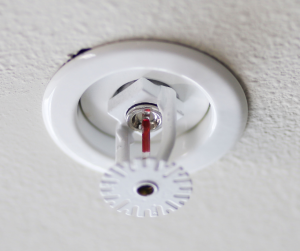 Fires are a major risk to religious organizations. Each year in the United States, there is an average of 1,780 fires in religious organizations. Damage from a fire can be more than just a financial burden. Religious buildings are often historical or contain works of art, artifacts or relics that can’t be replaced. A sprinkler system is a proven way to provide fire protection at your organization. In fact, research shows damages caused by fire were 73% less severe when religious institutions had a sprinkler system in place. Review the following for more information on implementing and maintaining a sprinkler system at your organization.
Fires are a major risk to religious organizations. Each year in the United States, there is an average of 1,780 fires in religious organizations. Damage from a fire can be more than just a financial burden. Religious buildings are often historical or contain works of art, artifacts or relics that can’t be replaced. A sprinkler system is a proven way to provide fire protection at your organization. In fact, research shows damages caused by fire were 73% less severe when religious institutions had a sprinkler system in place. Review the following for more information on implementing and maintaining a sprinkler system at your organization.
Risks
A poorly maintained sprinkler system is effectively the same as not having a sprinkler system at all. The damages incurred byfire can be just as severe if the sprinkler system is not properly installed and maintained. A neglected sprinkler system can alsocause its own damage. Here are some of the risks associated with sprinkler systems.
- Maintenance—Regular maintenance is required to keep sprinkler systems functioning at full capacity.
- Closed valves—According to the National Fire Protection Association, in 59% of the fires where sprinkler systems failed to operate, the water had been turned off. This may occur as a result of human error, an accident during maintenance, leakage concerns or intentional tampering.
Water damage—Even if the sprinkler system activates accordingly, it can cause water damage. If sprinkler heads are damaged, they may leak or dump water. These sprinkler systems typically operate with a fusible piece which may melt or burst in higher temperatures. Additionally, wet systems rely on charged water pipes, which keep water under pressure. These systems can burst if the temperature gets too low. The resulting water damage can destroy an organization’s librarybooks, paper documents, archives and other delicate artifacts.
Mitigation
If your organization does not have a sprinkler system already in place, see if one can be installed. It may not be feasible to add sprinkler systems to an existing structure. However, if your organization is able to add a sprinkler system or if it already has a sprinkler system in place, maintenance is key for continued functionality. The following are methods to keep sprinklers working properly:
- Inspections—Sprinkler systems should be inspected annually by an accredited individual. Ensure valves are “supervised”; this entails monitoring system valves so that issues can be fixed before they result in serious problems, such as a water shut-off incident. Valves should either be locked open or electronically supervised. During inspections, you should also ensure that Fire Department Connections are clear and accessible. This allows the fire department to push more water through in case of an emergency.
- Sprinkler shut-off preparation—Be prepared to shut off the sprinkler system if it’s set off through damage. You should know where the sprinkler shut-offs are and train key people to be able to shut them off and prevent undue damage.
- Other fire protection systems—A pre-action sprinkler system is an option for organizations looking to reduce the risk of an accidental release of water. These systems operate with a dry pipe. For the sprinklers to activate, the pre-action system must first identify a fire and then open the pre-action valve. The dual-action required to release water provides added protection against undue water damage. Gas-based systems are another alternative. If a fire occurs, these systems will release a mixture of gases to extinguish the fire. But, gas-based systems will only work in tightly sealed rooms where the gas can’t escape.
General Fire Protection
While important, sprinkler systems are just one step to protect your building from fire. Additional fire prevention measures should be adopted, especially if your building does not have a sprinkler system. Some of these measures include:
- Fire extinguishers—Ensure fire extinguishers are up to date and easily accessible.
- Alarms—Test alarms regularly and replace batteries yearly. A functioning alarm system will help detect fires quickly.
- Protection plans—Implement a fire protection plan at your organization. This includes identifying potential sources of fire and making plans reduce the likelihood of occurrence.
Preventing fires is not a one-off occasion. Regular maintenance is required to keep fire prevention systems functioning properly. With adequate care, however, the risk of fire can be greatly reduced.
© 2025 Zywave, Inc. All rights reserved


